|
Armed Forces Radio After World War II
By Edward A. Sharpe
Archivist SMEC
From SMEC Vintage Electrics Vol.#3m issue #1 1991 ( Now SMECC)
|
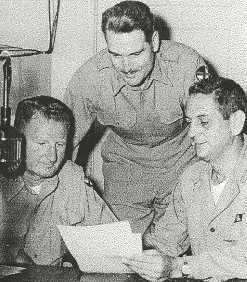 |
Seated at the microphone at radio station KTOK at left, Col. John P.
Dicks,
Chief Southern California Sector XVI Corp, during an interview by the
201st
AFRTS(USAR). Middle standing is Lt. Col. Harry Sharpe, Commander 201st
AORS
and on the right M/Sgt. Arthur Sheets, who is the announcer for the
station.
This interview was held at Fort MacArthur California July 16, 1958.
|
After World War II, as mentioned by Ivan Saddler, in his article, people
really did not know if the Armed Forces Radio Service would be continued
or mothballed until the concept was needed again. Several reasons
that the service did continue were; to provide on-base entertainment in
remote places of the world, in case there was ever another large war
they would be units that were easy to activate.
One way to keep the service alive at a minimal cost was to set up reserve
units. These units would train periodically, but not cause the overhead of
full time units. In this manner the cost was low, but should the need
arise, America had trained personnel that could be activated on a
moments notice.
My father, Major Harry A. Sharpe, was to join one of these reserve units
after World War II. It was an area that interested him, as it combined his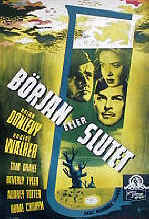 skills in the electrical and technical areas, with his interest in acting
and broadcasting. For a brief period after the war, Harry Sharpe went to
New York City and had made an attempt to establish a career in acting. I
have indeed seen him show up in late night movies, one in particular had a
plot that centered around the development of the atomic bomb. I remember
the name being, The Beginning or the End (1947-USA-War Drama). It was a small part, but I was
completely thrilled as I saw my father dressed as a scientist walk into a
room dressed in a white lab coat with a group of others scientists and
then walk out of the room.
skills in the electrical and technical areas, with his interest in acting
and broadcasting. For a brief period after the war, Harry Sharpe went to
New York City and had made an attempt to establish a career in acting. I
have indeed seen him show up in late night movies, one in particular had a
plot that centered around the development of the atomic bomb. I remember
the name being, The Beginning or the End (1947-USA-War Drama). It was a small part, but I was
completely thrilled as I saw my father dressed as a scientist walk into a
room dressed in a white lab coat with a group of others scientists and
then walk out of the room.
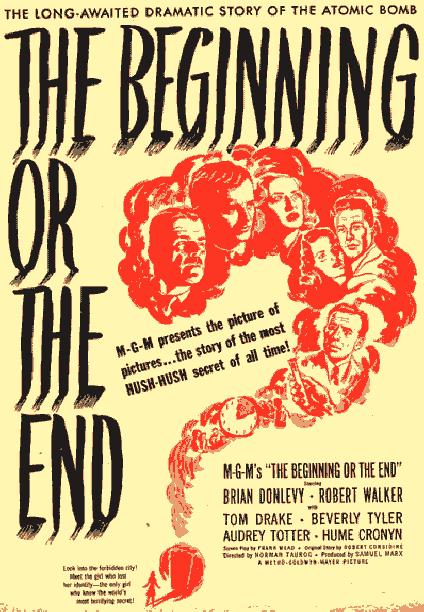
While in New York he joined the Army reserves although not in the AFRS, to
keep a reserve standing in the Army. With a combination of active
duty and reserve time, he figured it would be good to add to his
retirement.
In 1949, following his attempts in New York to start a profitable acting
career, Harry Sharpe returned to California where he married my mother
Mildred Gerber. He was attending the Geller Theatrical School in Los
Angles under the GI Bill, and then joined the 6447th AFRS Training unit
located in Los Angles California in October 12, 1949. The unit then
changed designation to the 6261 ARAAU Army Overseas Radio Station With
detachments 1,2 and 3. I was my parents first born son on December
21, 1951, to be followed by my brother Richard and sister Victoria.
Knowing what little work he was able to find in part time acting and real
estate sales was going to support a family, my father began a career
at Hughes Aircraft Company in April of 1952. Then in April 1954 the
unit was again renamed to Army Overseas Radio Station Network Hq. (Key
Station) 201st ARAAU with three network stations the 203ed, 204th, and
205th. He was promoted to Lt. Colonel in November of
1952.
I remember that summer camp was held at Fort MacArthur in San Pedro,
California. During the early days, while the family lived in Westwood (a
suburb of Los Angles) my father brought home the 'pup tent' that they used
at some point during exercises during camp. To a young kid, such as
myself, a real army tent just like in the movies, was indeed a great thing
to play in out in the back yard! I also have a recollection of a OD
colored can of tuna noodle casserole, and how neat it was to eat the
contents of that can my mother cooked up for me, as it was 'real Army
food'!
I remember as a child questioning my father about this broadcasting
station KTOK. I was most curious if I too could receive it on the standard
radio in my room but as he explained "We really don't transmit to
other radios, just into a dummy load for training." As a child once I
was in the building where the unit was housed on 5161 Suplivida Blvd. in
Van Nuys California, but this was when my father needed to pick up some
paperwork, not during the time they all met there, and of course I didn't
see any broadcasting activities going on in the building at that time.
My father retired from the Army Reserves August 12, 1962 and the command
of the unit was assumed by Major Walter Dundon. I was still very young and
although I have some memories of that period in my life, they are a bit
sketchy.
Harry Sharpe retired from Hughes in April 1973, were he and my mother
moved to Santa Rosa California.
My only other contact with what became AFRTS was while stationed at Luke
Air Force Base in Phoenix Arizona. I was to encounter AFRTS transcription
discs at the Office Of Information, which took care of base public
relations as well as producing the base news paper. This office was
responsible for a 'wired system' of broadcasting music to the chow
hall. Although I helped out, on a volunteer basis, with photography for
the base newspaper, this wired scheme did not interest me terribly much,
as it was not 'real' radio broadcasting. Had they actually had a radio
station on base I am sure that I would have spent all of my spare time
there!
In preparation of this article, I became acquainted with AFRTS in Sun
Valley California when attempting to find someone to give us
permission to use these photos of my father for this issue of VINTAGE
ELECTRICS. Not only was AFRTS going strong, but they had an archives and a
most wonderful Archivist named Dorothy McAdam! Dorothy and her
husband worked with Frank Capra during his film efforts through the Second
World War mentioned in the previous article by Ivan Saddler. It was a most
fortunate time to meet Dorothy, as the AFRTS has it's 50th anniversary
coming up in May of 1992. Anyone who was connected with AFRTS is welcome
to participate and needs to contact Dorothy McAdam at AFRTS (818-504-1313) for further information on
the reunion to be held in Los Angles.
AFRS changed it's name to AFRTS to encompass television broadcasting as
well, and now sends programming all over the world via satellite. They
have their own 'earth station' that is able to transmit directly to
communications satellites and the facility occupies a city block!
Army Reserves Get Radio Tests
Los Angeles' 6261st Army Reserves Administration Area Unit opens two weeks
of active training duty today at the Armed Forces Radio Service in
Hollywood.
Under command of Maj. Harry A. Sharpe, 28 members of the Army Overseas
Radio Station Unit will study worldwide operations of AFRS and receive general
training in radio production.
(A newspaper clipping from my father's file. Date and place published is unknown.)
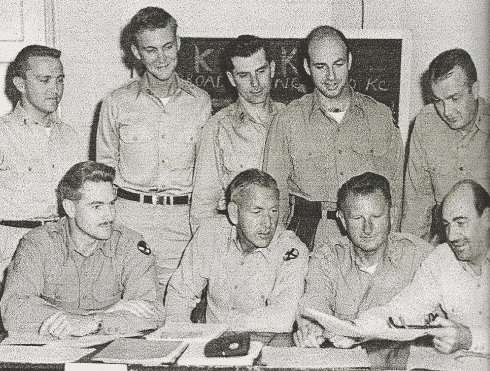
A group of officers at radio station KTOK, 201st AFRTS (USAR), confer with
Col. John P. Dicks, seated third from left, during an interview with Col. Dicks Chief Southern California Sector XVI Corps July 16, 1958 at Fort
MacArthur CA. Seated, from left to right are, Lt. Col. Harry Sharpe, Commander 201st AORS, Lt. Col. G.E. Forest, Col. John P. Dicks, Maj. C.E.
Bilyeu. Standing, from left to right are, Lt. Robert Stein, Lt. Frank Rowley, Capt. John Valentine, Lt. Noland West, Major Walter Dundon. (U.S.Army Photograph)
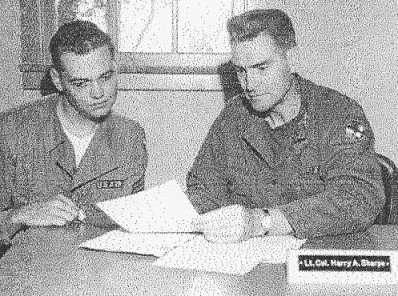
Lt. Col. Harry Sharpe (right) seated with unknown person on the left. Caption on the back of the photograph reads "Members of the 201st
ARAAU AORS Ft. MacArthur on active duty training 19 Aug 60." (U.S. Army
Photograph)
RESERVE ROUNDUP By SAM GORDON
FOURTEEN DAYS of active duty began today for 28 members of the 6261st Army
Reserve Administration Area Unit's Army Overseas Radio Station Unit.
Headed by Maj. Harry A. Sharpe, they'll study the worldwide operations of
Armed Forces Radio Service, 1016 N. McCadden Pl., and receive radio
production training in their duty at that headquarters.
During a trip to Columbia Broadcasting System's Hollywood headquarters,
they wll take part in a seminar on, radio dramatics, news editing and
reporting, radio engineering, radio acting, and station relations. Teachers will
include newsmen Frank Goss and Jack Beck and Sean McClory of the Abbey Players.
In a mobilization, the 33-man radio reserve unit could establish and
operate an AFRS Station overseas. Some of the reservists in civilian life are in
commercial radio and television production here.
(A newspaper clipping from my father's file. Date and place published is unknown.)
|
|
|
...My Father Was Spock's First Commander....
My brother and I would kid each other about
this.. actually Leonard Nimoy was in my father's AFRTS Reserve unit
during the Korean war era. Many people from Hollywood participated in
guard and reserve units during the Korean War. Ironically I remember
my father telling us they felt they were close to being called up to
active status but then the war was over...
It is funny how a line on a unit roster and
a father's recollections give you the edge on information game! -es
answers.com says...
Nimoy served in the U.S. Army Reserve, receiving final discharge in November, 1955 as a Sergeant. According to the National Archives and Records Administration, Nimoy's U.S. Army service record was destroyed in the 1973 National Archives Fire.
|
|
|
|
|
|
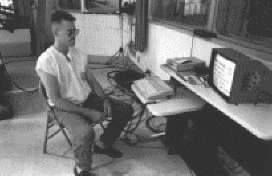
Joseph Dowdy
Talks About AFRTS
In The 90's
|
In 1989, I started volunteering at the Armed
Forces Radio and Televisions Services outlet, a part of the Far East
Network, at Marine Corps Air Station Iwakuni, Japan. I had already served
about five years and was working a Personal Financial Records Clerk Course
in a Disbursing Office known in Army and Air Force parlance as
"Finance." I had this vision that when I got out of the Marines
that I could go to work in the entertainment industry, so I thought I
would get some exposure and experience there.
As one of several volunteers, I learned various aspects of the roles that
they needed filled. One was as a TelePrompter operator, one was for
operating a television camera and the other was for floor directing. They
already had volunteers which were mostly high-school-aged boys from
military families stationed there. They only needed two volunteers each
time, which was always for the live news show at 6PM.
One day, I was approached by the Station Chief who had called me into his
office and asked me if I were interested in making a lateral move, which
meant that I could leave my clerk job and become a broadcast journalist. I
was thrilled. He helped me with the paperwork and we had done an aircheck
of my voice to see if I were satisfactory or untrainable. I passed and
started training on the job (this was called OJT). While working there and
learning the ropes of almost every role, I had acquired extremely valuable
skills useful for a future career in the entertainment industry.
I started off learning one of the more difficult but essential jobs at the
station, which meant that no one else wanted it basically, which was
on-air switching. This required that the shift operator, on weekends, be
the one to change the on-air product from program to PSA to sneak peak to
program again. Every minute of on-air product had a schedule and the
on-air switcher made sure everything got on the air on time. This was
using a Grass Valley Group switcher and it was big. It had all the effects
built in for fading from one source to another. Mostly, it was from
product to black to product again. However, at this station, we got a lot
of music videos from AFRTS headquarters, so some of the guys had an
MTV-style show on Friday nights.
One of my additional duties was to edit promos of upcoming movies and TV
shows using a 3/4" cuts-only edit bay. We also had an Abakas (A-52?)
that we used for the station bug (the station icon in the lower-right
corner) which included many key-frame effects as well.
After I had started and got completely trained in my on-air switcher
position, which I meant my shift was from noon Friday to midnight Friday
and the same on Saturday and Sunday, an unusual thing had happened. The
Station Chief that had got me there had been canned. He had created a
program that became highly controversial immediately. It was a kids show
but with an adult subtext to it. The playful characters who interacted
with the kids had names like "Fertile Fred" who was a farmer.
Well, considering that many of the higher-ranking people at the base were
very Christian, that did not fly very far or very fast. We got a new
Station Chief in a couple weeks later. Oddly enough, this was the same guy
who had turned me down years before when I visited the FEN outlet in
Okinawa to see if I could get a lateral move; instead of an aircheck, he
gave me a journalism test which he said I had failed (and he was a
broadcaster?).
Working at the station was great, but I had gotten a greater sense of
resentment from my co-workers at the station as time went along,
presumably because I was very good at every thing that I did and I hadn't
attended the prestiged and high-washout school normally required for all
broadcast journalists: DINFOS. I made sure that I would go to DINFO
(Defense Information School) as part of my lateral move. I'm sure that
some of it had to do with the new Station Chief as well. One day he pulled
me aside and told me that he had no idea why the previous Station Chief
had let me work there. What was really funny was that not once had I made
any screw-ups.
I think they really did want me to screw up as well. I was working a
36-hour shift on weekends and a new assistant Station Chief had arrived. I
don't remember if his role was new or if he had replaced someone. Anyway,
he obviously didn't like me much, either. He sat me down one day and told
me that I had to make-up for that extra 4 hours per week that I wasn't
working. He told me that I had to do a radio show. What was interesting is
that I remember that another crew member there had a radio show, but she
was terrible and got transferred, so I don't know if they planned to try
the same thing with me. So, they gave me about two hours of training and
let me sink or swim. I did a great job actually. However, the tiniest
thing that "might" be a screwup was highly scrutinized. What was
really interesting is that my radio show was Monday through Friday...that
meant I worked seven days a week.
Honestly, I was so thrilled that I didn't care what they threw at me. On
another day, the assistant Station Chief called me into his office again
and said that I needed to make up the other time as well because my show
was only one hour long. So I was called into a meeting where we were all
given new assignments to help the base commander to do public service
announcements (PSAs). I was told I would be working on a spot to help
reduce the number of cross-walk pedestrian incidents. So I came up with a
"Twilight Zone" parody which included green-screen effects. It's
sad that I never kept a copy of this. It was so popular that one day I was
in the shopping center on the base and was publicly praised for being the
"Crosswalk Zone" guy since I played a Rod Serling character in
my own spot.
Another assignment that I had been given was to help reduce the bicycle
accidents. So, I went out and shot video of how aggressive that bicyclists
are. These guys blow through stop signs and they don't drive on the right
side of the road and they are just plain thrill-seeking at times. Some of
them bike faster than some cars that drive cautiously. When I edited the
video of these guys on bicycles on the streets from just one vantage
point, and added a narration about how dangerous it is and how they could
be ticketed just the same as an automobile driver by the military police,
the aggressive bicyclists stopped their risky behavior. I got a
half-hearted thanks from the Station Chief when he told me that the base
commander called and was thrilled with the results.
When I shipped off to DINFOS, I got trained on the same equipment
essentially, but just before I left FEN Iwakuni, they received a digital
editing bay for non-linear editing. It wasn't assembled before I left so I
couldn't get trained on it.
I have one interesting anecdote about working in Japan. One day I got a
parking ticket in Hiroshima, which was not far from Iwakuni. When I went
to pick up my car, I had to pay the ticket. While paying the ticket, I had
to fill out a form that would be forwarded to my base commander and it had
a field which asked for the unit that I worked. Of course I put
"FEN" in the blank, but you should have seen the guy's face when
he read it. He turned around and told everyone that I worked at FEN and
they almost all stood up as a silent greeting to me. They all said,
"F-E-N" out loud like "Wow, it's a movie star." The
reason why is because FEN is so popular to Japanese that they even have a
magazine dedicated to it and it sells very well. In the magazine, you will
see the transcripts of what the stateside radio DJs are saying which helps
them with their Japanese and keeps them in tune with American culture. FEN
is also well-liked because they broadcast the cream of the crop of TV
shows for free to the Japanese public that are in the reach of an FEN
signal.
Joseph Dowdy
626.676.0407
joseph - at - iwilledityourvideo.com
|
| |
| |
 |
|
This booklet is designed primarily
for editors and writers and should be of practical help in dealing
with one of the most important pictures ever made by
Metro-Goldwyn-Mayer or by any other company, "The Beginning
Or The End".
Essential facts about the production are
in the booklet, with many background details, which can be the
source of feature stories, shorts and fillers.
It will be the job — and the pleasure
— of the M-G-M- publicity
department to co-operate with you in furnishing any further
information and material you may require.
|
|
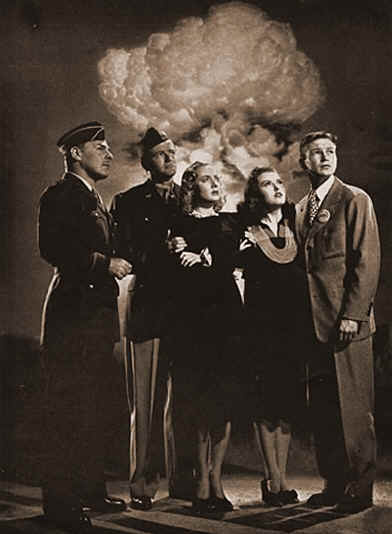
 |
Editor’s
note: from left to right the characters’ names are:
Leslie R. Groves, Jeff Nixon, Jean O’Leary, Anne
Cochran, and Matt Cochran. See “The Cast” for more
information.
 |
|
| "The timeless
moment that gives all of us a chance to prove that human beings
are made in the image and likeness of God" |

|
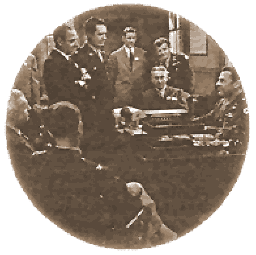
Chapter One

|
FILMING the story of the atom bomb
today, as the Atomic Age is still in its infancy and while the atom
bomb is contemporary history, marks an event unprecedented in the
motion picture industry.
From time to time, pictures
of outstanding significance have come from Hollywood visually to
entertain and enlighten film audiences throughout the world. But,
their subjects have been ripened by age, tested by the judgement of
time.
It was inevitable that
the story of the atom bomb should one day reach the screen. But,
today it marks the stoutest challenge ever placed upon Hollywood's
film making ingenuity. It is the human story of half a million
Americans, little men and big men, all doing their job in the
biggest, most complex task of all time.
From the moment an atom bomb
dropped on Hiroshima, on August 6, 1945, it became the greatest news
story ever to break upon the consciousness of the civilized world.
To this day, with discussions raging everywhere as to its possible
influence on the world's future... if any... it remains a vital
topic to every living person. |
|
It is in recognition of this fact
that Metro-Goldwyn-Mayer has assumed a rare responsibility and
acted with remarkable dispatch. In "The Beginning Or The
End", it is bringing to the screen the important, timely
story of the atom bomb. And despite the immensity of the
undertaking, filming of the picture's final scene was announced
less than one year following the date of Hiroshima's devastation.
In the intervening period, Hollywood
met and solved a staggering miscellany of problems — all bound
to arise when dealing with America's "top secret".
Not the least serious obstacle
was the obtaining of all approval from dozens of living
personalities to be portrayed in the picture, including the
President of the United States, Harry S. Truman. When a completed
screenplay was achieved, the White House joined the War Department
in officially approving it.
Paving the way
for one of the rare instances that a living President has been
portrayed on the screen, consent was achieved to depict Mr. Truman
as he made his historical decision to use the atom bomb against
Japan.
Without such official approval and
without the government cooperation tendered Hollywood throughout,
the true story of the atom bomb never could have been filmed. |
|
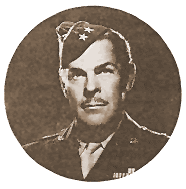
Chapter Two

|
THE STORY behind the filming of
"The Beginning or The End" actually begins back in 1939,
in the small Iowa town of Denison. It was about the time when the
world's scientists were beginning to make headway in their study of
nuclear "fission", a process involving the bombardment of
uranium with neutrons.
Important experiments
in this country, as well as Germany, France, Denmark and England,
proved that a neutron striking a uranium nucleus caused that nucleus
to split with the release of tremendous amounts of energy. These
were the experiments that led to the first nuclear chain reaction in
history, at the University of Chicago on December 2, 1942.
But, the story beginning to
unfold in Denison was much more typical of Hollywood than was the
story of scientific achievement going on elsewhere. It had all the
elements of a Cinderella story.
There was a pretty girl,
a high school student. There was a young professor, her chemistry
teacher. It was of no apparent importance at the time, but the
friendship begun in that classrom was to continue even when the girl
went on to become a movie star, and the small town teacher rose to
become a brilliant atomic scientist. While each took separate roads
to success, they continued to write each other news of their
progress and adventures. |
|
The school girl who
became an actress was Donna
Reed. Her teacher, turned scientist, was Dr. Edward Tompkins.
The first indication Miss Reed had
that her friend was associated with the atomic project was the
newspaper headline revealing the bombing of Hiroshima, and the story
telling of the important research done at Oak Ridge, Tennessee. A
previous letter from Dr. Thompkins had been postmarked "Oak
Ridge".
The actress promptly sat down and wrote
a fan letter to the scientist. He responded with a letter telling of
his work and then setting forth a startling suggestion. As a member
of the Association of Oak Ridge Scientists, he was anxious to
acquaint the people with the potentialities of the weapons they had
helped create. This understanding was necessary for a quick and sure
control of the bomb, they felt.
"News releases, magazine articles, pamphlets
and even a book have been or are being prepared by our
members," he wrote. "We have made a good start but much
remains to be done. We are still largely failing to reach the 'man
on the street.' "
With this in mind, he
proposed a motion picture. "Do you think a movie could be
planned and produced to impress, upon the public, the horrors of
atomic warfare, the fact that other countries can produce atomic
explosives and the vulnerability of civilization to attack by these
explosives?"
Donna Reed read the letter. Then
she showed it to her husband, Tony Owen, a former agent well versed
in the ways of picture making. He saw in it the idea for not only an
important. but also an outstanding motion picture. Fairly leaping to
the telephone. he called his close friend, Producer Samuel Marx at
Metro. Goldwyn .Mayer. The next morning, they sat down to breakfast
together at the Beverly Wilshire Hotel, Dr. Tompkins' letter spread
out before them.
Thus did a high school friendship
in Iowa result in a motion picture
being filmed that has been labeled by government officials. military
leaders and scientists as the most important undertaking in
Hollywood history.
|
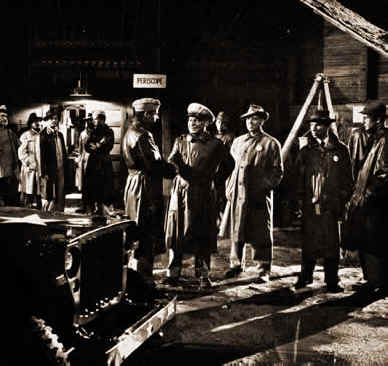 |
| "Good luck —
I'll be six miles further away" |
|
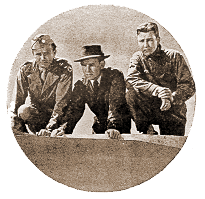
Chapter Three

|
FOLLOWING the eventful breakfast,
developments came fast. Samuel Marx carried the idea to Louis B.
Mayer, M-G-M studio head. Other studio executives were called into
session, and the enthusiasm was unanimous. There was just one
stumbling block. It was realized at once that such a picture could
not be filmed in its proper scope without cooperation from
government, military and scientific leaders who formed an integral
part of the story.
Marx was dispatched immediately
to Oak Ridge, accompanied by Owen. They were met at their plane by
Dr. Tompkins, who greeted them with, "I'm glad you're
here. I hope M-G-M wiII want to make this picture because we
scientists are frightened to death!".
The visitors from Hollywood were
fingerprinted, photographed and questioned. From a meeting of
scientists, they were given an outline of the exciting events
leading up to the atomic discovery. They went from one key figure
to another. Each gave his personal approval of the film, but
declared that official approval should come from someone in higher
authority.
The same was true in Washington, D. C.
where they went next. Major General Leslie R. Groves and Brigadier
General Thomas Farrell recounted the higher phases of the
project's military side. But, authority for such a picture still
had to come from higher up.
Finally, they reached
the President of the United States!. |
|
Mr. Truman, following an uninterrupted hour of discussion, gave
his enthusiastic approval. "As we left the President's
office," Marx recalls, "he stopped us at the door to
say, as near as I can remember it, 'Make a good picture. One that
will tell the people that the decision is theirs to make. ...this
is the beginning or the end!' Outside the door, we realized that
we had not only what we had come for but also a title for the
motion picture.
"The President had named it…
'The Beginning or the End'. "
When Marx returned to Hollywood,
after further research at such atomic centers as the University of
Chicago and Columbia University, and a discussion of the film's
religious aspects with Cardinal Francis J. Spellman, he reported
that he had found the most amazing and most human story he had
ever heard. Particularly at Oak Ridge. where he had talked to
scientists, wives and laborers, had he been impressed with the
fact that, the atom bomb story is largely their story.
In Hollywood with the picture now
definitely on the schedule, Norman
Taurog, remembered for his "Boys' Town" and other
outstanding pictures. won the directing nod over a host of top
bracket candidates. The picture was given a No. 1 priority at
M-G-M -- first call on Hollywood's most extensive list of stars
and featured players, first call on the vast production resources
of the world's largest studio.
Next step was the assignment of
writers. Bob Considine, famed war
correspondent, responsible for "Thirty Seconds Over
Tokyo", was named to write the original treatment. Commander
Frank Wead, U. S. Navy ( retired), was selected to do the
screenplay. His latest had been the highly successful , "They
Were Expendable". Considine continued the research begun by
Marx. From the East, where he maintained a constant contact with
the real-life players in the atomic story, he wired his material
page by page to Hollywood where Wead took over.
As soon as the story outline began to
reveal itself, camera crews branched
out from Hollywood to all parts of the country. Quietly but
earnestly, filming began on Hollywood's atomic drama -- in the
Pentagon Building and the White House in Washington. D. C., at Oak
Ridge, Los Alamos, Alamafordo, New Mexico, University of Chicago
and Columbia University -- wherever any portion of the real-life
atomic drama had been enacted.
|
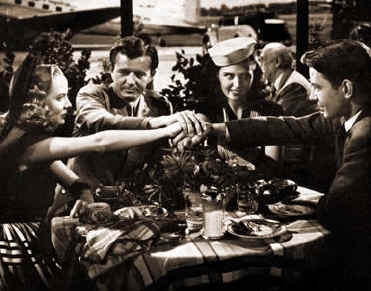 |
| "We'll meet
again after the war" |
|
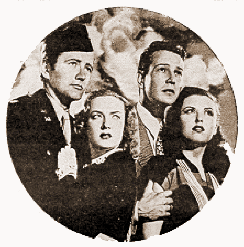
Chapter Four

|
THE NEXT task facing the film makers
was the immense one of casting the story's record-making 212
speaking roles. A few months earlier, before the return from service
of many of Hollywood's leading actors, it would have been
impossible, All but four of the roles are played by men.
Adding to the difficulty of this job
twas the fact that a majority of the roles were depicting living
personalities, the largest number ever arrayed in one film story.
Even the fictional characters had to be cast with great care.
because of what they represented.
Prominent persons to be portrayed on the
screen ranged from two Presidents of
the United States ~ Harry S. Truman and the late Franklin Delano
Roosevelt - to leaders of every phase of the vast atomic project.
These included Generals Brehon Somervell. W. D. Styer, Groves and
Farrell, Rear Admiral William S. Parsons and Colonel John Lansdale
on the armed forces side: Professor Albert Einstein, Professor
Enrico Fermi, Dr. J. Robert Oppenheimer, brilliant University of
California physicist who headed the Los Alamos development and
supervised the New Mexico bomb test, Dr. Vannevar Bush, director of
the Office of Scientific Research and Development.
Dr. Arthur Compton,
director of the Metallurgy Project at the University of Chicago, Dr.
James B. Conant, President of Harvard University, Dr. Ernest O.
Lawrence, director of the Radiation Laboratory at the University of
California and inventor of the famed cyclotron and many others from
the world of science; K. T. Keller of Chrysler Motors, W. S.
Carpenter, Jr.. of the du Pont Company, James A. Rafferty of Union
Carbide Company and Harry A. Winne of General Electric among the
industrialists.
In every case, the script was shown
to I these men and approved. Frequently' they proffered suggestions
for augmenting scenes and these were incorporated into the
screenplay, Almost without exception,. actors were selected of the
same physical make-up and type as the men they were to depict.
although the first requirement always was proved acting abilitty. |
|
As stars of the picture, Brian
Donlevy was named after weeks of careful consideration to play
General Groves. Army chief of the atomic project, and Robert Walker.
fresh from his portrayal of the late Jerome Kern in "Till the
Clouds Roll By," was selected to appear as the general's aide.
Tom Drake, following his spiritually keyed
performance in "The Green Y
ears," was decided upon as the ideal type to symbolize
Arnerica's youthful scientists on the screen. Beverly Tyler,
introduced so successfully as Drake's sweetheart in the previous
picture. was chosen as his young bride, experiencing the hardships
suffered by the wives and families of the men on America's top
secret undertaking.
Audrey Totter, another brilliant young
actress, won the role of Jean O'Leary,
General Groves' confidential secretary who later ,.was decorated by
Congress as a woman who knew the secret - and kept it. Hume Cronyn ,
was picked for the important Dr. Oppenheimer role, .Joseph Calleia
as Professor Fermi,. Jonathan Hale as Dr. Bush,. Henry O'Neill as
General Farrell, Warner Anderson as Admiral Parsons (a Navy captain
at the time depicted in the film), and Barry Nelson as Colonel Paul
W. Tibbets, Jr., pilot of the B-29 that dropped the atom bomb on
Hiroshima.
England and Canada were represented in
their participation in the project by Hurd Hatfield and Richard
Haydn, two of Hollywood's most distinguished performers, in the
roles of the British scientists called to America on atomic
research, and Damien O'Flynn. as C. D. Howe, Canadian Minister of
Munitions.
In its effort to tell the full
story, Hollywood sought to present the
project not only as an all-out, all-American development, but also
as the perfectly coordinated Allied triumph that it represents.
|
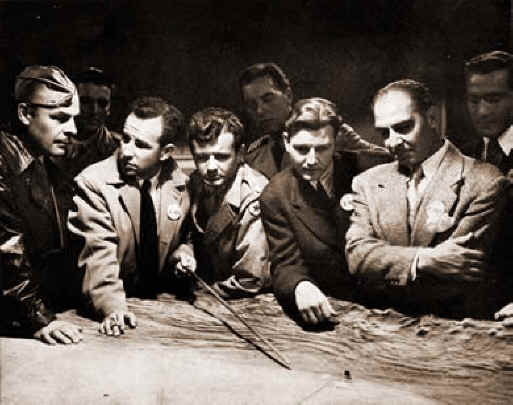 |
|

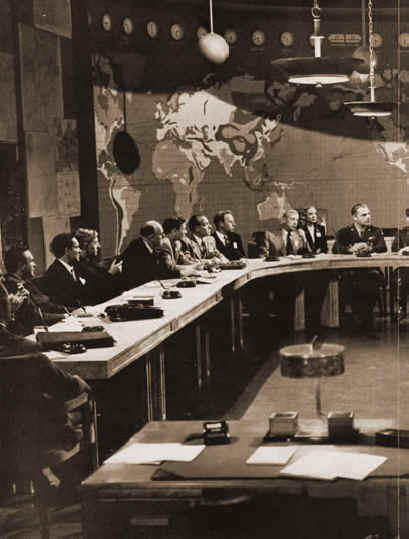
|
| "AMERICA
GATHERS ITS MIGHT — MILITARY, SCIENTIFIC, INDUSTRIAL" (left |
|
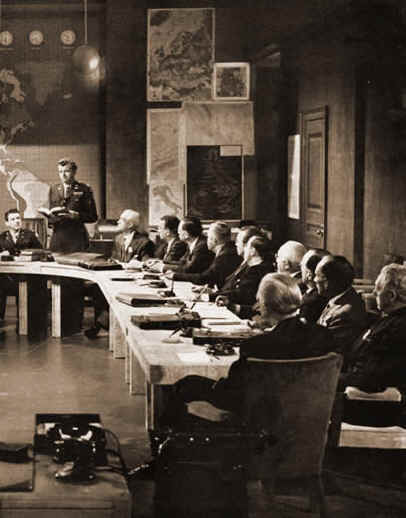 |
| "AMERICA GATHERS
ITS MIGHT — MILITARY, SCIENTIFIC, INDUSTRIAL" (right) |
|
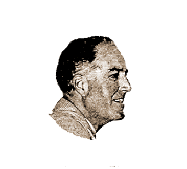
Chapter Five

|
THREE of the film's outstanding
dramatic scenes revolved around two American Presidents. and two of
the most delicate problems of casting in Hollywood history. The
first shows the late President Roosevelt as he launched America on
its two billion dollar atomic project., often termed the biggest
gamble of all time. Mr. Roosevelt at the Little White House in Warm
Springs Georgia, on the final day of his life. The third, as the
re-enactment of the fateful meeting in Potsdam, Germany, when Mr.
Truman gave his order for the use of the atom bomb against Japan.
Half-a-dozen skilled actors were
considered for the role of Mr.
Roosevelt before the final choice was made. Then Godfrey Tearle, who
was born in New York but attained his greatest prominence in the
English stage and screen, was flown in from London to Hollywood for
the role. Although a brother of the late star f silent films, Conway
Tearle, the actor never had previously visited the motion picture
capital.
His startling resemblance to
the famed American leader created an unusual stir wherever he went
in Hollywood, just as it had in New York on his last appearance on
l3roadway, in "The Flashing Stream" in 1939, and during
the war when he entertained American troops in England and in Italy.
An interesting sidelight,
and still another challenge to the filming of the picture, was the
duplication of the President's office on an M.G.M. sound stage. To
do a faithful job of it, the studio obtained permission from the
White House to photograph various sections of the office. .even
pictures on the walls were photographed, then blown up to their
original size in .Hollywood and colored. In addition to White House
permission, releases then had to be obtained from the copyright
owners of each painting, which included several received by
President Truman from the National Museum, and an oil painting of
Mr. Roosevelt.
Recreating the same room as
it was five years ago was more difficult, but it was achieved with
the same fidelity , after careful scrutiny of photographs made of it
at that time.
An unusual commentary on the habits
of two Presidents was revealed in the
picturing of the President's desk in the two sequences. For the
scene of Mr. Truman, the desk was shown with scarcely more than a
dozen objects neatly. placed on its surface. During the term of Mr.
Roosevelt, the desk top contained ninety-eight articles. including
six ashtrays, six boxes of matches and countless miniature
elephants, dogs. horses, donkeys and other animals, all souvenirs
sent by admirers. |
|
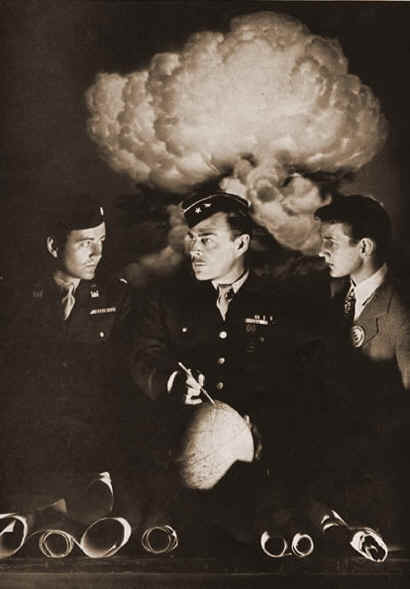
|
| "You will take
the bomb to the Marianas — and use it!" |
|
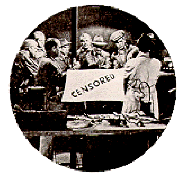
Chapter Six

|
DR. TOMPKINS letter to Donna Reed
suggesting the film on the atom bomb was dated October 23. 1945.
Within a month, studio executives had waxed enthusiastic over the
plan, Marx had made his trip to Oak Ridge and visited President
Truman, General Groves. Dr. Oppenheimer and a multitude of other
atomic leaders. Shortly after, the official announcement came that
Metro-Goldwyn-Mayer ,was preparing to film "The Beginning or
the End," the story of the atom bomb.
At the turn of the year,
the tremendous research campaign was under way. but not a line of
screenplay was on paper. Considine and Wead now \were ready to start
writing, however. Within four months, their job was completed. So.,
too, was the research delving into top secret developments at
hundreds of atomic installations, demanding contacts with close to a
thousand different people who had been connected in some degree with
the project. In five months, Hollywood had achieved a task that
ordinarily would have taken the film makers between one and two
years..
The finished script approved all around,
cameras began turning on the sound stages.
Eleven weeks later, Director Taurog said 'Cut" to his final
scene several days ahead of his schedule. "This speedy
handling of a difficult assignment," he declared, "can
be attributed only to the interest and enthusiasm displayed not only
by all the actors involved but also by every man on the picture's
crew. Everyone ,who has been engaged on this picture seems to have
caught the spirit of it , and responded accordingly.".
From the start of filming,
despite the tremendous interest throughout Hollywood in the picture,
the sets for "The Beginning or the End" were tightly
closed to visitors. Only working press members were allowed
entrance, and then only on designated days. A sign on the stage door
announced the rescinding of all regular studio passes, and a studio
police officer was on hand to make it stick.
This "security measure,"
installed by the studio, served a double purpose. Although the
script had been approved by the White House and the War Department,
it still was required that the completed picture be shown to
government officia1s in Washington, D.C. before being released, and
in addition, the size of the cast and the difficult nature of many
scenes made a closed set advisable in view of the demand for speed.
With film cutting and musical
scoring being pushed even while the
picture was being made on the sound stages, studio officials
announced that the picture detailing the story of the atom bomb
would be presented to the public as soon as the machinery of
distribution would permit. |
|
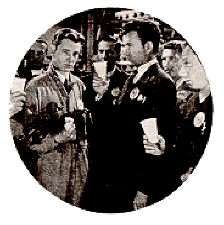
Chapter Seven

|
"THE BEGINNING OR THE END" has
been described as the story of the atom bomb. It is also the story
of the men and women who solved the atomic mystery, and who helped
American win a life and death race to become the first nation to
build an atom bomb. And, possibly most important of all, it is a
story that tells all the peoples of the world just what they face
today - the crucial problem of whether atomic energy is to be used
for good or evil.
It is a story of our own times that is so
vital and so spectacular that no
fiction could match.
Yet, Hollywood has not made a straight
documentary film story of it.
Believing that an entertaining drama will carry far more influence
and appeal to audiences in general, a handful of fictional
characters have been introduced to give the story a cohesiveness
that might otherwise be lacking. Each of these characters, however,
is in actuality a composite figure drawn from real-life persons who
served their country in its greatest crisis. Each has a distinct
significance.
Tom Drake, for example, representing the
young scientists in his role, can be
interpreted as expressing the conscience of mankind faced with
releasing atomic energy in wartime. His character was drawn from
dozens of young scientists interviewed at Oak Ridge and Los Alamos
by the studio officials. Robert Walker, as a young military officer,
can be regarded as typifying the duty of man in wartime. His is the
job to end a terrible conflict as quickly as possible.
Through these two and their
contrasting impulses, the whole drama
is told from the earliest atomic research in Europe and America to
the bombing of Hiroshima and the return of peace.
Included in the exciting highlights
are the arrival of British scientists
in America to work on the project, the appeal by Professor Einstein
to the late President Roosevelt for government support of atomic
development, the historic Chicago "brickpile" test that
saw the first self-sustaining nuclear chain reaction known to man,
the combining of scientists. military men and industrialists on the
vast project, the growth of Oak Ridge, the New Mexico bomb test, the
exciting take-off of B-29s from Tinian and the blasting of Japan. |
|
The filming of many scenes
will be long remembered in Hollywood.
For instance, the reenactment of the "brickpile" test
underneath Stagg Field at the University of Chicago, an event which
one atomic expert, Dr. Henry T. Wensel, prophesied would "2000
years from now, when all our present sources of energy are
exhausted. become recognized as possibly the most important date in
all history."
Keen interest also was displayed by
workers and actors alike in scenes
taking place in such famed atomic laboratories as those at Columbia
University. the University of Chicago and Los Alamos. for these.
actual atomic equipment valued at more than $100,000 was rented by
the studio, and additional thousands spent in duplicating
instruments that could not otherwise be obtained. Included in the
rented equipment were various types of Geiger-Muller counters. for
detecting radioactivity, and a cathode ray oscillograph for
measuring energy and indicating fission.
The greatest excitement on the set came
with the filming of the New Mexico bomb test at Alamogordo. and the
Hiroshima raid. To depict the blinding flash of the atom bomb,
greater than mid-day light, it is estimated that over two-and-a-half
million watts of light were used for each scene, the equivalent of
more than 42,000 average house bulbs. More than a million watts
powered a battery of huge skylights surrounding the set with a
million-and-a-half watts coming from 100 spot lamps. An intricate
system demanding ten miles of cable connected the set with the
studio's main generator, bringing a simultaneous blinding flash from
all the lamps and throwing a maximum load on the generator..
For these and all other scenes showing the
atom bomb, iall persons not directly
connected with the film were barred from the stage. The one
exception was Dr. Oppenheimer, who visited Hollywood at the precise
moment when Actor Hume Cronyn was depicting him in one of the most
dramatic events of the New Mexico test. The young, thinnish
physicist, in distinct contrast to the popular conception of
bearded. dignifieJ scientific genius, saluted his screen prototype
by doffing his hat and tossing it to Cronyn, shouting as he did so, "Hello,
Oppy!"
|
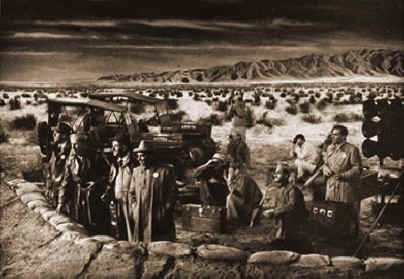 |
| "It's equal to
the destructive power of 20,000 tons of TNT!" |
|
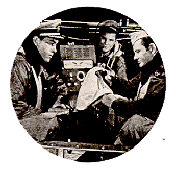
Chapter Eight

|
COL. CHARLES SWEENEY, who piloted the
B-29 "The Great Artiste," that dropped the bomb on
Nagasaki. was just one of many men closely associated with the atom
homb who visited Hollywood during the making of "The Beginning
Or The End,' and commented on the imperativeness of the film story.
Others included General Groves, when he inspected ships in Southern
California as they were about to leave for the Bikini Atoll tests,
Dr. Harold C. Urey of the Institute of N Nuclear Studies at the
University of Chicago, Dr. Leo Szilard, prominently connected with
the early stages of the project, and Dr. Oppenheimer.
In addition to Col. Sweeney, seven
other atomic experts came to Hollywood as technical advisors on
every phase of the atomic development. They were the assurance of an
authentic film.
The first to arrive was the man whose
letter had started the whole thing,
Dr. Edward Tompkins. the scientist who had written his suggestion
for an atom bomb picture to Donna Reed, was sent to Hollywood by the
Association of Oak Ridge Scientists. He remained ten weeks,
rendering advice throughout the writing of the script. Joining him
at the studio was another scientist, Dr. W. Bradford Shank of the
Federation of American Scientists, who was associated with the
development at Los Alamos.
Just prior to the start of filming,
two new arrivals from Washington. D. C. were Dr. Henry T. Wensel, on
leave from the Bureau of Standards, and Col. William Consodine. who,
as a deputy in charge of Security and Public Relations, served as an
aide to General Groves. Later they were joined by a fourth
scientist, Dr. David Hawkins, an associate of Dr. Oppenheimer at the
University of California and at Los Alamos. His advice on the
filming of the atom bomb explosion on the New Mexico desert, as well
as on vital research scenes in the Los Alamos laboratories, was
considered invaluable.
An Army foursome to work alongside
scientific advisors, in much the same
cooperative manner that they did during the war, was completed with
the appearance of Major Glen W. Landreth, who was on Tinian when the
bombers took off for Japan, Major Paul Van Sloun, who visited
Hiroshima and viewed what remained of the Jap city, and Col.
Sweeney.
This corps of technical advisors,
believed the largest ever employed on a motion picture. was
unanimous in commending Hollywood for its all-out effort to make a
picture in keeping with the importance of its subject. Dr, Wensel,
who as Chief of the Technical Division of the Manhattan District and
Technical Aide to the Chairman of the Office of Scientific Research
and Development toured every major atomic installation in the
country, was particularly impressed, both with Hollywood's effort
and with the urgent need for such a film.. |
|
|
"Any attempt to give a clearer
conception of just what an atom bomb is, of the magnitude of
the job required for its construction and of its tremendous
destructive force, cannot help but be of value to the world
today."
"I may be prejudiced, as a scientist who
feels very close to this subject, but to me this is the most
important motion picture ever made. Its subject is one that every
American should be conscious of, and thinking about. The atom bomb
is in their laps, it is their job to get a workable solution to the
problem it has posed to the world today."
"During my four months' association
with this picture, I have become convinced that it can be
expected to give the average person his clearest understanding to
date of the most lethal weapon ever devised by man. and the
essential problems of atomic energy now confronting the world."
"That, to me, makes the picture of
unique value to all humanity."
Col. Sweeney expressed a similar feeling when he commented, "It
is a public service to make and distribute to the world a picture of
this nature. Having seen two of the atom bombs dropped, and what
they did to two Jap cities, I can assure you that their tremendous
power has not been exaggerated, and from all I can gather, the two
bombs I saw were only firecrackers compared with the bombs that can
be made in the future."
Dr, Shank augmented these views by saying, "The
atomic question is the most vital one before the whole world today.
Whether we are alive ten years from now or not, whether we live in
caves or in cities, depends upon how many average people concern
themselves with this problem.
"It is my opinion, and that of the men of the
Federation of American Scientists with whom I have talked that this
motion picture will do a definite good in helping to inform the
people of the destructive potentialities of the atom bomb, and in
highlighting the possibilities for peace time application of atomic
energy. Its value, too, is that it will reach the mass of the people
-- and they, not just a handful of leaders, will solve the problem
if it is to be solved."
It is in recognition of a duty to mankind, as well as of a
human story of rare significance. that Metro-Goldwyn-Mayer, with
unique attention to authenticity has filmed .'The Beginning or the
End."
|
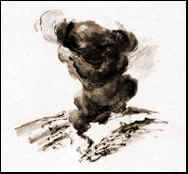 |
|
The
Main Title Credits
|
"THE
BEGINNING OR THE END"

Starring

BRIAN DONLEVY • ROBERT WALKER
with

TOM DRAKE • BEVERLY TYER
AUDREY TOTTER • HUME CRONYN
HURD HATFIELD • JOSEPH CALLEIA
GODFREY TEARLE As President Roosevelt
VICTOR
FRANCEN • RICAHARD HAYDN
JONATHON
HALE • JOHN LITEL
HENRY O"NEILL • WARNER ANDERSON
BARRY NELSON
ART BAKER as President Truman
LUDWIG STOSSEL as Dr Albert Einstein
Screen Play by FRANK WEAD
Original Story by ROBERT CONSIDINE
| Director of Photography |
RAY JUNE, A.S.C. |
| Film Editor |
GEORGE BOEMLER |
| Musical Director |
DANIELE
AMFITHEATROF |
| Recording Director |
DOUGLAS SHEARER |
| Art Direction |
CEDRIC GIBBONS
HANS PETERS |
| Set Direction |
EDWIN B. WILLIS |
| Associate |
KEOGH GLEASON |
| Special Effects |
WARREN NEWCOMBE
A. ARNOLD GILLESPIE |
| Associate |
DONALD JAHRAUS |
| Montage Effects by |
PETE WALLBUSCH |
| Costume Supervision |
IRENE |
| Make-Up Created by |
JACK DAWN |
Scientific Technical Advisors:

DR. H.T. WENSEL
DR. EDWARD R. TOMPKINS —
Oak Ridge, Tennessee
DR.
DAVID HAWKINS — Los
Alamos, New Mexico
W. BRADFORD
SHANK— Los Alamos, New Mexico
Military Technical Advisors:

WILLIAM A. CONSODINE, COL. —
Manhattan Project
CHARLES W. SWEENEY, Lt. Col. A.C.
With Acknowledgements to Mr. TONY OWEN
for his Cooperation
Produced by SAMUEL MARX
Directed by NORMAN TAUROG
|
|
The
Cast
|
"THE
BEGINNING OR THE END"

| Major
General Leslie R. Groves |
BRIAN DONLEVY |
| Colonel Jeff
Nixon |
ROBERT WALKER |
| Matt Cochran |
TOM DRAKE |
| Anne Cochran |
BEVERLY TYLER |
| Jean O'Leary |
AUDREY TOTTER |
| Dr. J. Robert
Oppenheimer |
HUME CRONYN |
| Dr. John Wyatt |
HURD HATFIELD |
| Dr. Enrico
Fermi |
JOSEPH CALLEIA |
| President
Roosevelt |
GODFREY TEARLE |
| Dr. Marre |
VICTOR FRANCEN |
| Dr. Chisholm |
RICHARD HAYDN |
| Dr. Vannevar
Bush |
JONATHAN HALE |
| K. T. Keller |
JOHN LITEL |
| General Thomas
F. Farrell |
HENRY O'NEILL |
| Captain
William S. Parsons |
WARNER
ANDERSON |
| Colonel Paul
Tibbets, Jr. |
BARRY NELSON |
| President
Truman |
ART BAKER |
| Dr. Albert
Einstein |
LUDWIG STOSSEL |
| Dr. Harold C.
Urey |
JOHN HAMILTON |
| Dr. James B.
Conant |
FRANK FERGUSON |
| Dr. E. .P..
Wigner |
TOM STEVENSON |
| Dr. Leo
Szilard |
JOHN GALLAUDET |
| Grace Tully |
NELLA.WALKER |
| Charles G.
Ross |
EDWARD EARLE |
| Dr. O. R.
Frisch |
MARTIN KOSLECK |
| Dr. Arthur H.
Compton |
MORONI OLSEN |
| Dr. Troyanski |
NORMAN LLOYD |
| Pilot at
Tinian |
JIM DAVIS |
| Walter S.
Carpenter, Jr. |
CHARLES
TROWBRIDGE |
| Dr. W. H. Zinn |
FRANK WILCOX |
| General Brehon
Somervell |
HENRY HALL |
| Lieut. General
W. D. Styer |
PAUL HARVEY |
| VEY Quaker
Scientist |
LARRY JOHNS |
| Dr. Rand |
ROBERT EMMETT
KEANE |
| Dr. Ernest O.
Lawrence |
JAMES BUSH |
| Clinic Doctor |
TREVOR
BARDETTE |
| Colonel John
Lansdale |
WILLIAM WRIGHT |
| C. D. Howe |
DAMIAN O'FLYNN |

|
|
The
Billing
M•G•M
Presents
|
"THE
BEGINNING OR THE END"

BRIAN
DONLEVY • ROBERT WALKER
with
TOM
DRAKE • BEVERLY TYLER
AUDREY TOTTER • HUME CRONYN
Screenplay by FRANK WEAD
Original Story by ROBERT CONSIDINE
Produced by SAMUEL MARX

A METRO-GOLDWYN-MAYER PICTURE |
|
| |
| |
| |
| |
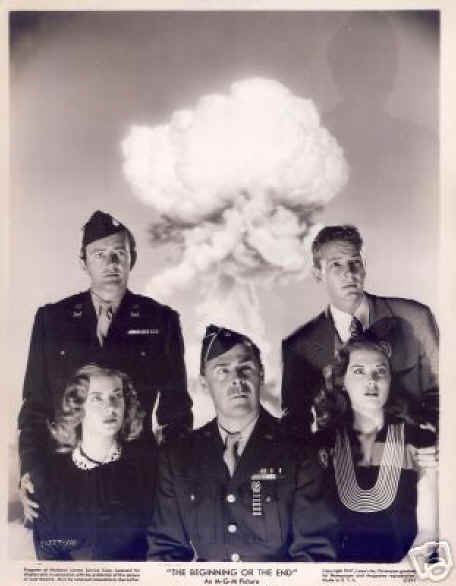
Black and white 8x10
glossy photo of MGM's THE BEGINNING OR THE END (1947) with Robert Walker,
Tom Drake, Beverly Tyler, Audrey Totter and Brian Donlevy.
|

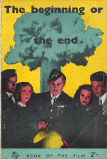 |
| |
Bridlington's Time
Capsule
(from www.Bridlington.net)
(The UK)
Somewhat ambitiously for Bridlington, the
town was looking forward to the year 2197 when a time capsule was buried
in the path leading to the Town Hall. A stone tablet marks the spot
stating that the capsule was buried in 1947, “marking the beginning of
the Atomic Age.”
Councillor F. F. Millner, the Mayor, said
at the ceremony that it was a “peculiar experience writing to someone
who would be mayor of this borough in 250 years time.”
He went on to add: “I do not fear the
atomic age from the viewpoint of destruction. I believe we are at the
beginning of a very great scientific movement in that we can use atomic
energy in nature to do good and to do our work. During the 250 years
which will pass before the capsule is opened there will be great
scientific advances.”
It was at 12.15pm on Saturday, November
11, 1947, that the capsule was buried. It was 12in x 9in x 9in in size
(300 x 230 x 230mm) and completely weatherproof. Mr D. Bowden, the
manager of the Regal Cinema (on Promenade; at the time of writing,
February 2000, it is the Gala Bingo Hall), had arranged the scheme,
assisted by Mr S. Tenser, assistant manager. No-one knows what the mayor
wrote to his future counterpart, but along with his message went the
following:
- a photograph of the mayor and members of the council and chief
officials
- a street plan
- an aerial photograph of the town
- the municipal year book
- an official guide
- a Bridlington guide for 1939
- the electoral register for 1947
- the Medical Officer for Health’s report
- the annual report of the public library
- Rock’s print of the entrance to the harbour
- “The Dissolution of Bridlington Priory” by J. S. Purvis
- a negative film of civic buildings and other places, including the
prefabricated houses
- a copy of the corporation accounts
- engravings by J. Stephenson from drawings by G. Bulmer of the
harbour
- three maps of Bridlington and district
- new coins of 1947
- a book of the film “The Beginning or The End”
- picture postcards of the town
- a typical cafe menu of the day
- a schedule of the Chrysanthemum Show
- “The Roman Villa of Rudston” by F. R. Pearson (known to the
writer as “Clippy,” he was history master at Bridlington School in
1948)
- “Bridlington Charters” by J. S. Purvis
- Prickett’s “History of the Priory”
- Thompson’s “Sketches of Bridlington"
- George Hardwick’s “What to See in Bridlington”
- and a triangle badge of Associated British Cinemas Ltd.
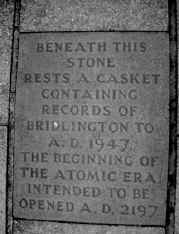 The
writer's copies of the last five books are illustrated here and it is
likely that additional copies of the books are with other collectors in
Bridlington. These books, as well as many others of local historical
interest, are available for reference purposes in the Bridlington Room
at the library. The only title not known to the writer is “The
Beginning or The End.” Perhaps this dealt with atomic energy. The
writer's copies of the last five books are illustrated here and it is
likely that additional copies of the books are with other collectors in
Bridlington. These books, as well as many others of local historical
interest, are available for reference purposes in the Bridlington Room
at the library. The only title not known to the writer is “The
Beginning or The End.” Perhaps this dealt with atomic energy.
The film of the civic buildings will not be much use in 2000 without the
relevant projector and even less use in another 200 years time.
The prefabricated houses referred to, of course, were constructed just
after the war to provide emergency accommodation. To the best of the
writer’s knowledge, they lasted many more years than intended. They
were erected where part of the Gypsey Road estate is now and on Jubilee
Avenue. No doubt many Bridlington residents will remember them with
either affection or disgust.
 The one item
the writer would like to see is the cafe menu from 1947. What would it
consist of? Starter: Bowl of Brown Windsor Soup or Pea Soup? Main
course: Fish and Chips with Bread and Butter or Meat Pie and Boiled
Potatoes? Sweet: Spotted Dick and Custard? It’s fairly certain that
the meal would end with a Pot of Tea for Two. The one item
the writer would like to see is the cafe menu from 1947. What would it
consist of? Starter: Bowl of Brown Windsor Soup or Pea Soup? Main
course: Fish and Chips with Bread and Butter or Meat Pie and Boiled
Potatoes? Sweet: Spotted Dick and Custard? It’s fairly certain that
the meal would end with a Pot of Tea for Two.
If we were to bury a time capsule today, what would be put in it? There
are several books about Bridlington currently available, many of them
with illustrations of days gone by. But what about how Bridlington looks
today? There’s a multitude of picture postcards, some videos (remember
to put a video player in the capsule - and simple instructions!),
and, of course, the current Bridlington guide.
Copies of the local newspaper should go in too. Funny how there was no
mention of either the Bridlington Chronicle or the Bridlington Free
Press in the capsule buried in 1947.
To celebrate the Millennium, perhaps Bridlington should plan burying a
second time capsule this year to last the thousand years to the next
millennium. Now that would be something! Anyone out there willing to
sponsor the idea?
Mike Wilson
|
| |
| |
| |
|




 skills in the electrical and technical areas, with his interest in acting
and broadcasting. For a brief period after the war, Harry Sharpe went to
New York City and had made an attempt to establish a career in acting. I
have indeed seen him show up in late night movies, one in particular had a
plot that centered around the development of the atomic bomb. I remember
the name being, The Beginning or the End (1947-USA-War Drama). It was a small part, but I was
completely thrilled as I saw my father dressed as a scientist walk into a
room dressed in a white lab coat with a group of others scientists and
then walk out of the room.
skills in the electrical and technical areas, with his interest in acting
and broadcasting. For a brief period after the war, Harry Sharpe went to
New York City and had made an attempt to establish a career in acting. I
have indeed seen him show up in late night movies, one in particular had a
plot that centered around the development of the atomic bomb. I remember
the name being, The Beginning or the End (1947-USA-War Drama). It was a small part, but I was
completely thrilled as I saw my father dressed as a scientist walk into a
room dressed in a white lab coat with a group of others scientists and
then walk out of the room.



















 The
writer's copies of the last five books are illustrated here and it is
likely that additional copies of the books are with other collectors in
Bridlington. These books, as well as many others of local historical
interest, are available for reference purposes in the Bridlington Room
at the library. The only title not known to the writer is “The
Beginning or The End.” Perhaps this dealt with atomic energy.
The
writer's copies of the last five books are illustrated here and it is
likely that additional copies of the books are with other collectors in
Bridlington. These books, as well as many others of local historical
interest, are available for reference purposes in the Bridlington Room
at the library. The only title not known to the writer is “The
Beginning or The End.” Perhaps this dealt with atomic energy. The one item
the writer would like to see is the cafe menu from 1947. What would it
consist of? Starter: Bowl of Brown Windsor Soup or Pea Soup? Main
course: Fish and Chips with Bread and Butter or Meat Pie and Boiled
Potatoes? Sweet: Spotted Dick and Custard? It’s fairly certain that
the meal would end with a Pot of Tea for Two.
The one item
the writer would like to see is the cafe menu from 1947. What would it
consist of? Starter: Bowl of Brown Windsor Soup or Pea Soup? Main
course: Fish and Chips with Bread and Butter or Meat Pie and Boiled
Potatoes? Sweet: Spotted Dick and Custard? It’s fairly certain that
the meal would end with a Pot of Tea for Two.